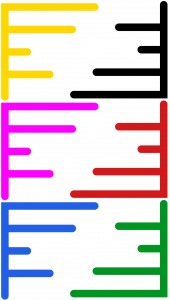3 Bilingual Concordancers
 Although term banks can be very useful for understanding concepts (e.g. through definitions) or for identifying possible equivalents in another language, sometimes the term or expression that a translator needs may not be included in the term bank. Other times, a translator may want to see a term in context in order to better understand how to use it properly in the target text. In such cases, a free online bilingual concordancer can be very useful.
Although term banks can be very useful for understanding concepts (e.g. through definitions) or for identifying possible equivalents in another language, sometimes the term or expression that a translator needs may not be included in the term bank. Other times, a translator may want to see a term in context in order to better understand how to use it properly in the target text. In such cases, a free online bilingual concordancer can be very useful.
A bilingual concordancer is a fairly straightforward tool: it allows users to search through a bilingual parallel corpus to find information that might help them to complete a new translation task. For example, if a user encounters a word or expression that they do not know how to translate, they can look in the bilingual parallel corpus to see if this expression has been used before, and if so, how it was dealt with in that previous translation.
In order for a bilingual concordancer to work, the source and target texts must first be aligned, which means that corresponding text segments – usually sentences – are linked together. See the figure below for an example of how the text from the English and French versions of the website of the University of Ottawa’s School of Translation and Interpretation can be aligned at the sentence level.
| Welcome to the University of Ottawa’s School of Translation and Interpretation (STI) | Bienvenue au site de l’École de traduction et d’interprétation (ÉTI) de l’Université d’Ottawa |
| Translation is one of the most creative and lucrative ways for people who love working with languages to enjoy earning their living. | Quand on aime les langues, traduire représente une activité professionnelle à la fois créative et lucrative. |
| And in Canada, translation is a constant. | Or, au Canada, la traduction est omniprésente. |
| The job options are countless: in federal and many provincial governments, in law offices and courts, in NGOs and many other agencies, in film and media, in advertising, journalism, academia, and, of course, in literature. | Les débouchés dans ce domaine sont innombrables : administration fédérale ou provinciale, cabinets d’avocats, palais de justice, ONG, sans oublier l’audiovisuel, la publicité, le journalisme, le monde universitaire et, bien entendu, la littérature. |
| Since the University of Ottawa is a bilingual institution, classes and exams (and many administrative activities) take place in both languages, and there is a constant interplay between Canada’s two official languages. | À l’Université d’Ottawa, institution bilingue, les cours et les examens (tout comme une grande part de l’administration) ont lieu en anglais et en français, ce qui donne lieu à une interaction constante entre les deux langues officielles du Canada. |
Once the texts are aligned, the translator can use the bilingual concordancer to consult the corpus. By entering a term or expression in the search box, the translator can retrieve all examples of that term from the corpus. The source language sentences containing the search term will be shown on the left, and the corresponding translations in the target language, which should normally contain an equivalent for the search term, will be displayed on the right.
TradooIT Bilingual Concordancer
As part of their TradooIT tool suite, the Canadian company Okidoo Inc. has developed a free online bilingual concordancer that searches a corpus of over 850 million words. The majority of texts the in the corpus come from Canadian government websites, although some texts are taken from international organizations. The source for each sentence is always displayed immediately below the sentence, which allows users to see at a glance whether or not the content is Canadian.
When translating for a Canadian audience, it is preferable to use terms or expressions that are representative of the Canadian variety of English or French, and because TradooIT’s corpus contains such a high percentage of Canadian sources, it is easier to identify authentic examples of Canadian language in this resource. There are other similar bilingual concordancers on the web, such as Linguee or Glosbe; however, the corpora used by these other tools contain a greater proportion of non-Canadian texts, meaning that it is more challenging to locate examples of Canadian usage. Therefore, when translating for a Canadian audience, TradooIT’s corpus and bilingual concordance are likely to be more helpful.
Try it! How can you use sources to identify authentic Canadian language? 
- Go to the TradooIT bilingual concordancer website.
- Set the source language to English and the target language to French using the drop-down lists below the search box.
- Type or copy/paste the term parking lot into the search box and then click on the button showing a magnifying glass or hit the Enter key.
- Look at the results, which are displayed in two columns in the centre of the screen labelled English and French.
-
- In the English column (on the left), there is a series of English sentences containing the term parking lot.
- In the French column on the right, there is a series of French sentences that are translations of the English sentences.
- What French equivalents for parking lot can you see?
- In most of the French sentences, the French equivalent is stationnement, but in some cases, parking
- Look at the source information listed below each sentence. This indicates the text from which each sentence was taken.
-
- Notice that most of the sources are from Canadian websites (indicated by a .ca domain name), while a few sources are not Canadian (e.g. sites with a .com domain name).
- The examples taken from the Canadian sources tend to contain the French Canadian term stationnement, while the examples taken from non-Canadian sources tend to be the ones that use the term parking, which is more common elsewhere.
- Try doing this same search (for parking lot) in another free online bilingual concordancer tool such as Linguee.
- What do you notice about the results?
- You will probably find that the proportion of Canadian sources in Linguee is lower than the proportion of Canadian sources in TradooIT, making it more challenging to identify authentic examples of Canadian usage.
- Return to the TradooIT bilingual concordancer and try another example.
- Set the source language to English and the target language to French using the drop-down lists below the search box.
- Type or copy/paste the term octopus into the search box and then click on the button showing a magnifying glass or hit the Enter key.
- Look at the results, taking note of the sentences in the French column on the right-hand side.
-
- Some sentences contain the term poulpe while others contain the term pieuvre.
- Turn your attention the far left-hand side of the screen and find the subheading “Sources”.
-
- This list indicates where the texts in the corpus come from.
- Click on the item called “PARLGCCA”, which means that the texts come from the parl.gc.ca domain (i.e., texts from the Parliament of Canada). By clicking on “PARLGCCA”, only those examples that come from the Parliament of Canada texts are shown.
-
- In these Canadian examples, the term pieuvre seems to be more common.
- Return to the list of sources and this time click on “EUROPARL”, which will show only those examples that come from the European parliament texts.
-
- In these European examples, poulpe seems to be the more commonly used term.
In addition to the basic search and display options, TradooIT’s bilingual concordancer has some more advanced features that allow users to incorporate wildcard characters for searching and to apply filters for sorting and viewing the results in different ways. To learn more about the advanced features of TradooIT’s bilingual concordancer, consult the online user guide. You may also have noticed that, in addition to displaying the English and French sentences that it retrieves from the corpus, the TradooIT tool also displays any relevant results that it finds from the Canadian term banks that were discussed in the previous section. These term bank results are displayed at the top of the screen above the two columns containing the English and French sentences. Together, this combination of term records and concordance results that come from mainly Canadian sources provides a good indication of the language that is characteristic of the Canadian varieties of English and French.


